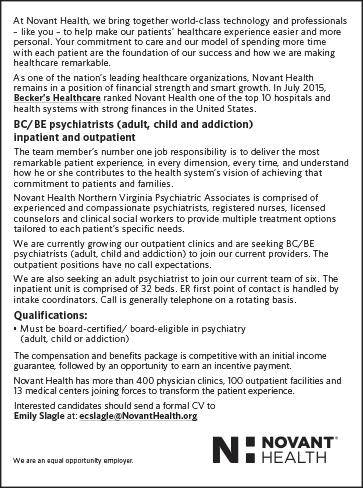Spring 2016 Issue |
The Future of Healthcare and Behavioral Healthcare
By Varun Choudhary, MD, DFAPA
Outgoing PSV President
 |
Varun Choudhary, MD, DFAPA |
What does the future hold for the healthcare industry and specifically our field of behavioral health? Our current system is in a state of unprecedented flux akin to a seismic sea change that can make predictions difficult. Yet, there are trends that can be tracked and followed that allow us to approximate and understand the direction and progression of key factors.
We have witnessed the movement toward institutional consolidation in the past few years where hospitals have transformed themselves into larger healthcare systems, by assimilating physician practices and partnering with specialty groups. The driver in this movement is the shift away from the current reimbursement method, and the awareness of a proliferation of payment models beyond the strict fee for service. In 2015 MACRA (Medicare Access and CHIP Reauthorization ACT) was signed into law. This eliminated the antiquated SGR formula that drove Medicare reimbursement and introduced a plan for a complete shift to value-based payment models. CMS is currently exploring numerous blend-of-payment models in the value-based realm including pay for performance, care management/patient-centered medical home, bundled payment, shared savings/ACO, as well as a full or partial risk/capitation models.
This shift to value-based reimbursement will also lead to value-based contracting. Value-based contracting is an arrangement where a provider agrees to go at risk for a portion of the negotiated payment if the service fails to meet or exceed certain performance standards. An example of this is the current CMS hospital readmission penalty if certain clinical quality standards are not met.
This leads to the next area of need and development: a recognized, standardized, simplified and streamlined set of accepted metrics and outcome measures. Without the development of a universally accepted consistent quality cycle measurement framework, providers will continue to struggle with measurement proliferation and data collection. Therefore, there will be an impetus to align and simplify a standard set of accepted measures among commercial and government payers. Considering that the new leader of America’s Health Insurance Plans (AHIP) is Marilyn Tavenner, the former head of CMS, there is hope that such alignment and simplification can occur.
 What does all of this mean for behavioral health professionals? Changes in financing approaches, including behavioral health parity and healthcare reform, have increased the use of managed care approaches in both the public and private markets. Pay-for-performance and prospective payment concepts will increasingly penetrate the behavioral healthcare arena. The integration movement will make behavioral health professionals increasingly responsible for developing an enhanced understanding of medical issues. There will be a greater emphasis in the reduction of emergency room visits, hospitalizations, re-hospitalizations, institution and residential placements and on strengthening community-based care. Higher value will be placed on a robust development of social support models that include longer term and supportive housing, increased comprehensive care collaboration, and wraparound services that produce positive impact on outcomes. There will be a greater focus on wellness and recovery, primary prevention and preventative care. An emphasis on diet, nutrition and lifestyle will become just as important as the reinforcement of the importance of compliance with medications and treatment.
What does all of this mean for behavioral health professionals? Changes in financing approaches, including behavioral health parity and healthcare reform, have increased the use of managed care approaches in both the public and private markets. Pay-for-performance and prospective payment concepts will increasingly penetrate the behavioral healthcare arena. The integration movement will make behavioral health professionals increasingly responsible for developing an enhanced understanding of medical issues. There will be a greater emphasis in the reduction of emergency room visits, hospitalizations, re-hospitalizations, institution and residential placements and on strengthening community-based care. Higher value will be placed on a robust development of social support models that include longer term and supportive housing, increased comprehensive care collaboration, and wraparound services that produce positive impact on outcomes. There will be a greater focus on wellness and recovery, primary prevention and preventative care. An emphasis on diet, nutrition and lifestyle will become just as important as the reinforcement of the importance of compliance with medications and treatment.
Innovative technology will drive advancements and efficiencies in the system. Telemedicine has already been recognized as an innovative means of increasing access and management of patient care. This will continue and grow with the proliferation of home monitoring devices, smartphone apps, and remote care methods that allow patients to receive care from the comfort of their homes. Real time data transmission to interactive dashboards accessible by healthcare professionals at the touch of a button will allow for an exponential increase in the effectiveness of healthcare delivery. The growth of population health tools and analytical systems will lead to the need for new structures for data governance within health systems. This may require new information technology tools and platforms to drive the creation of real interoperable electronic health records and true portability of healthcare information in a consumer- driven system.
Finally, words of wisdom spoken by a famous management sage noted: “The best way to predict the future is to create it.” We have a golden opportunity as healthcare professionals to help create and reinvent our system of healthcare delivery. We should seize the moment.





